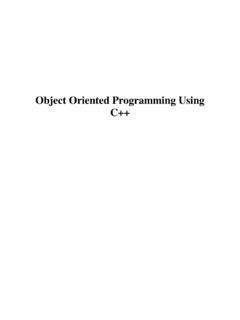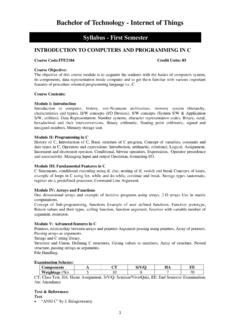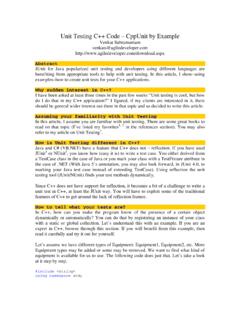Transcription of Linkers and Loaders
1 Linkers & Loaders by John R. Levine Table of Contents 1. Table of Contents Chapter 0: Front Matter .. 1. Dedication .. 1. Introduction .. 1. Who is this book for? .. 2. Chapter summaries .. 3. The project .. 4. Acknowledgements .. 5. Contact us .. 6. Chapter 1: Linking and Loading .. 7. What do Linkers and Loaders do? .. 7. Address binding: a historical perspective .. 7. Linking vs. loading .. 10. Two-pass linking .. 12. Object code libraries .. 15. Relocation and code modification .. 17. Compiler Drivers .. 18. Linker command languages .. 19. Linking: a true-life example .. 20. Exercises .. 25. Chapter 2: Architectural Issues .. 27. Application Binary Interfaces .. 27. Memory Addresses .. 28. Byte Order and Alignment .. 28. Address formation .. 30. Instruction formats .. 31. Procedure Calls and Addressability .. 32. Procedure calls .. 33. 2 Table of Contents Data and instruction references .. 36. IBM 370.
2 37. SPARC .. 40. SPARC V8 .. 40. SPARC V9 .. 42. Intel x86 .. 43. Paging and Virtual Memory .. 45. The program address space .. 48. Mapped files .. 49. Shared libraries and programs .. 51. Position-independent code .. 51. Intel 386 Segmentation .. 53. Embedded architectures .. 55. Address space quirks .. 56. Non-uniform memory .. 56. Memory alignment .. 57. Exercises .. 57. Chapter 3: Object Files .. 59. What goes into an object file? .. 59. Designing an object format .. 60. The null object format: MS-DOS .COM files .. 61. Code sections: Unix files .. 61. headers .. 64. Interactions with virtual memory .. 65. Relocation: MS-DOS EXE files .. 72. Symbols and relocation .. 74. Relocatable .. 75. Relocation entries .. 78. Symbols and strings .. 80. summary .. 82. Unix ELF .. 82. Relocatable files .. 85. ELF executable files .. 92. ELF summary .. 94. Table of Contents 3. IBM 360 object format .. 94. ESD records.
3 95. TXT records .. 97. RLD records .. 97. END records .. 98. Summary .. 98. Microsoft Portable Executable format .. 99. PE special sections .. 105. Running a PE executable .. 107. PE and COFF .. 107. PE summary .. 108. Intel/Microsoft OMF files .. 108. OMF records .. 110. Details of an OMF file .. 111. Summary of OMF .. 114. Comparison of object formats .. 114. Project .. 115. Exercises .. 117. Chapter 4: Storage allocation .. 119. Segments and addresses .. 119. Simple storage layout .. 120. Multiple segment types .. 121. Segment and page alignment .. 124. Common blocks and other special segments .. 125. Common .. 125. C++ duplicate removal .. 127. Initializers and finalizers .. 130. IBM pseudo-registers .. 131. Special tables .. 134. X86 segmented storage allocation .. 134. Linker control scripts .. 136. Embedded system storage allocation .. 138. Storage allocation in practice .. 138. Storage allocation in Unix Linkers .
4 139. 4 Table of Contents Storage allocation in ELF .. 141. Storage allocation in Windows Linkers .. 144. Exercises .. 146. Project .. 147. Chapter 5: Symbol management .. 149. Binding and name resolution .. 149. Symbol table formats .. 150. Module tables .. 153. Global symbol table .. 154. Symbol resolution .. 157. Special symbols .. 158. Name mangling .. 158. Simple C and Fortran name mangling .. 158. C++ type encoding: types and scopes .. 160. Link-time type checking .. 163. Weak external and other kinds of symbols .. 164. Maintaining debugging information .. 164. Line number information .. 164. Symbol and variable information .. 165. Practical issues .. 166. Exercises .. 167. Project .. 167. Chapter 6: Libraries .. 169. Purpose of libraries .. 169. Library formats .. 169. Using the operating system .. 169. Unix and Windows Archive files .. 170. Unix archives .. 170. Extension to 64 bits .. 174.
5 Intel OMF libraries .. 174. Creating libraries .. 176. Searching libraries .. 177. Table of Contents 5. Performance issues .. 179. Weak external symbols .. 179. Exercises .. 181. Project .. 181. Chapter 7: Relocation .. 183. Hardware and software relocation .. 183. Link time and load time relocation .. 184. Symbol and segment relocation .. 185. Symbol lookups .. 186. Basic relocation techniques .. 186. Instruction relocation .. 188. X86 instruction relocation .. 189. SPARC instruction relocation .. 189. ECOFF segment relocation .. 191. ELF relocation .. 193. OMF relocation .. 193. Relinkable and relocatable output formats .. 194. Other relocation formats .. 194. Chained references .. 195. Bit maps .. 195. Special segments .. 196. Relocation special cases .. 197. Exercises .. 197. Project .. 198. Chapter 8: Loading and overlays .. 201. Basic loading .. 201. Basic loading, with relocation .. 202. Position-independent code.
6 203. TSS/360 position independent code .. 203. Per-routine pointer tables .. 206. Table of Contents .. 207. ELF position independent code .. 208. 6 Table of Contents PIC costs and benefits .. 212. Bootstrap loading .. 213. Tree structured overlays .. 214. Defining overlays .. 217. Implementation of overlays .. 220. Overlay fine points .. 222. Data .. 222. Duplicated code .. 222. Multiple regions .. 223. Overlay summary .. 223. Exercises .. 223. Project .. 224. Chapter 9: Shared libraries .. 227. Binding time .. 230. Shared libraries in practice .. 231. Address space management .. 231. Structure of shared libraries .. 232. Creating shared libraries .. 233. Creating the jump table .. 234. Creating the shared library .. 235. Creating the stub library .. 235. Version naming .. 237. Linking with shared libraries .. 238. Running with shared libraries .. 238. The malloc hack, and other shared library problems.
7 240. Exercises .. 243. Project .. 244. Chapter 10: Dynamic Linking and Loading .. 247. ELF dynamic linking .. 248. Contents of an ELF file .. 248. Loading a dynamically linked program .. 253. Starting the dynamic linker .. 253. Table of Contents 7. Finding the libraries .. 254. Shared library initialization .. 255. Lazy procedure linkage with the PLT .. 256. Other peculiarities of dynamic linking .. 258. Static initializations .. 258. Library versions .. 259. Dynamic loading at runtime .. 260. Microsoft Dynamic Link Libraries .. 260. Imported and exported symbols in PE files .. 261. Lazy binding .. 266. DLLs and threads .. 267. OSF/1 pseudo-static shared libraries .. 267. Making shared libraries fast .. 268. Comparison of dynamic linking approaches .. 270. Exercises .. 271. Project .. 271. Chapter 11: Advanced techniques .. 273. Techniques for C++ .. 273. Trial linking .. 274. Duplicate code elimination.
8 276. Database approaches .. 278. Incremental linking and relinking .. 278. Link time garbage collection .. 281. Link time optimization .. 282. Link time code generation .. 284. Link-time profiling and instrumentation .. 284. Link time assembler .. 285. Load time code generation .. 285. The Java linking model .. 287. Loading Java classes .. 288. Exercises .. 290. Project .. 291. 8 Table of Contents Chapter 12: References .. 293. Perl books .. 295. Front Matter 0-1. Chapter 0. Front Matter $Revision: $. $Date: 1999/06/09 00:48:48 $. Dedication To Tonia and Sarah, my women folk. Introduction Linkers and Loaders have been part of the software toolkit almost as long as there have been computers, since they are the critical tools that permit programs to be built from modules rather than as one big monolith. As early as 1947, programmers started to use primitive Loaders that could take program routines stored on separate tapes and combine and relocate them into one program.
9 By the early 1960s, these Loaders had evolved into full-fledged linkage editors. Since program memory remained expensive and limited and computers were (by modern standards) slow, these Linkers contained complex features for creating complex memory overlay struc- tures to cram large programs into small memory, and for re-editing previ- ously linked programs to save the time needed to rebuild a program from scratch. During the 1970s and 1980s there was little progress in linking technolo- gy. Linkers tended to become even simpler, as virtual memory moved much of the job of storage management away from applications and over- lays, into the operating system, and as computers became faster and disks larger, it became easier to recreate a linked program from scratch to re- place a few modules rather than to re-link just the changes. In the 1990s Linkers have again become more complex, adding support for modern fea- tures including dynamically linked shared libraries and the unusual de- mands of C++.
10 Radical new processor architectures with wide instruction words and compiler-scheduled memory accesses, such as the Intel IA64, will also put new demands on Linkers to ensure that the complex require- ments of the code are met in linked prograsm. 0-2 Front Matter Who is this book for? This book is intended for several overlapping audiences. Students: Courses in compiler construction and operating systems have generally given scant treatment to linking and loading, often because the linking process seemed trivial or obvious. Although this was arguably true when the languages of interest were Fortran, Pascal, and C, and operating systems didn't use memory mapping or shared libraries, it's much less true now. C++, Java, and other object-oriented languages require a much more sophisticated link- ing environment. Memory mapped executable program, shared li- braries, and dynamic linking affect many parts of an operating sys- tem, and an operating system designer disregards linking issues at his or her peril.






